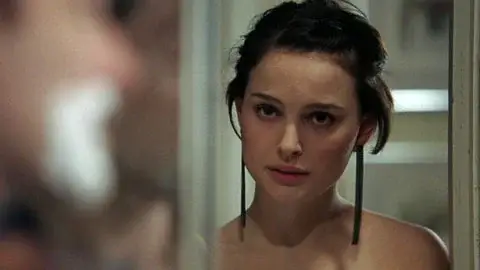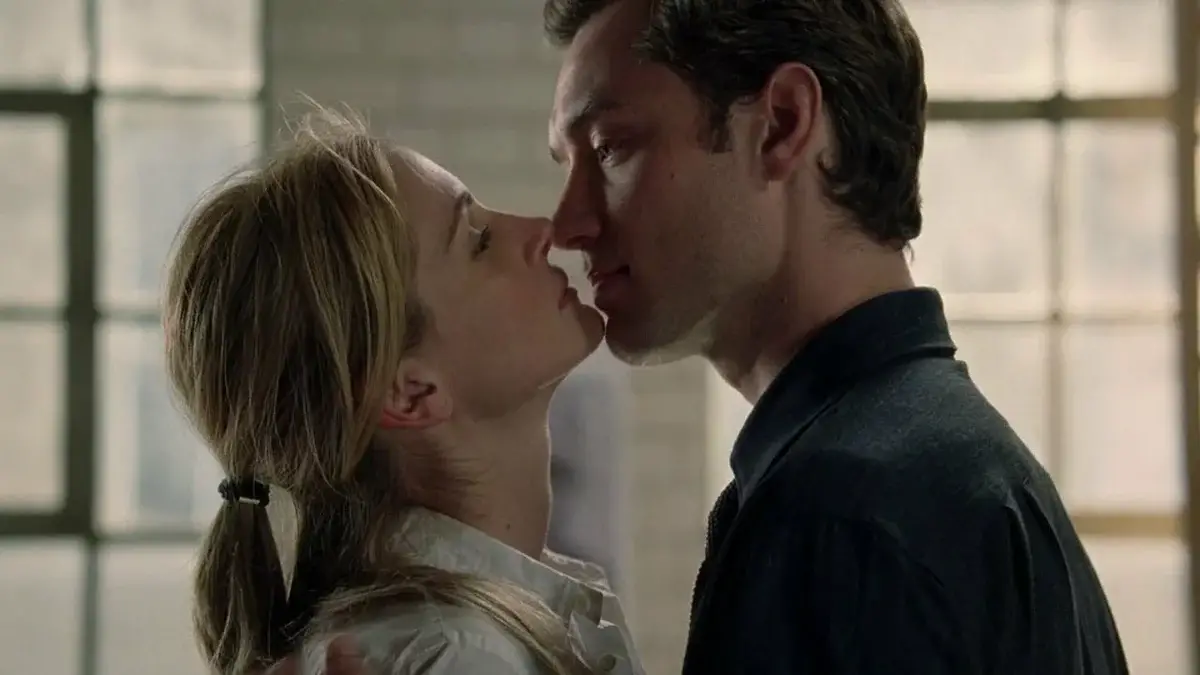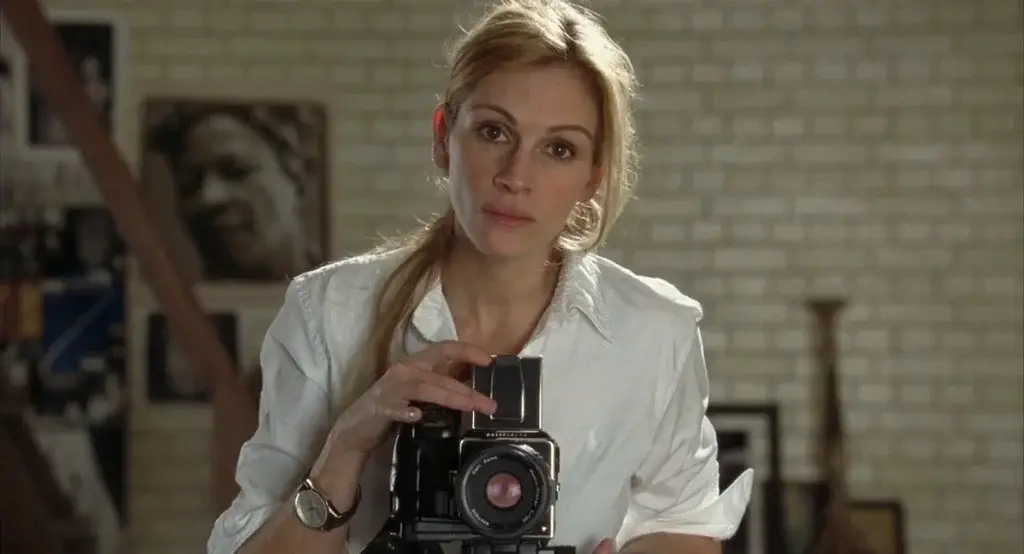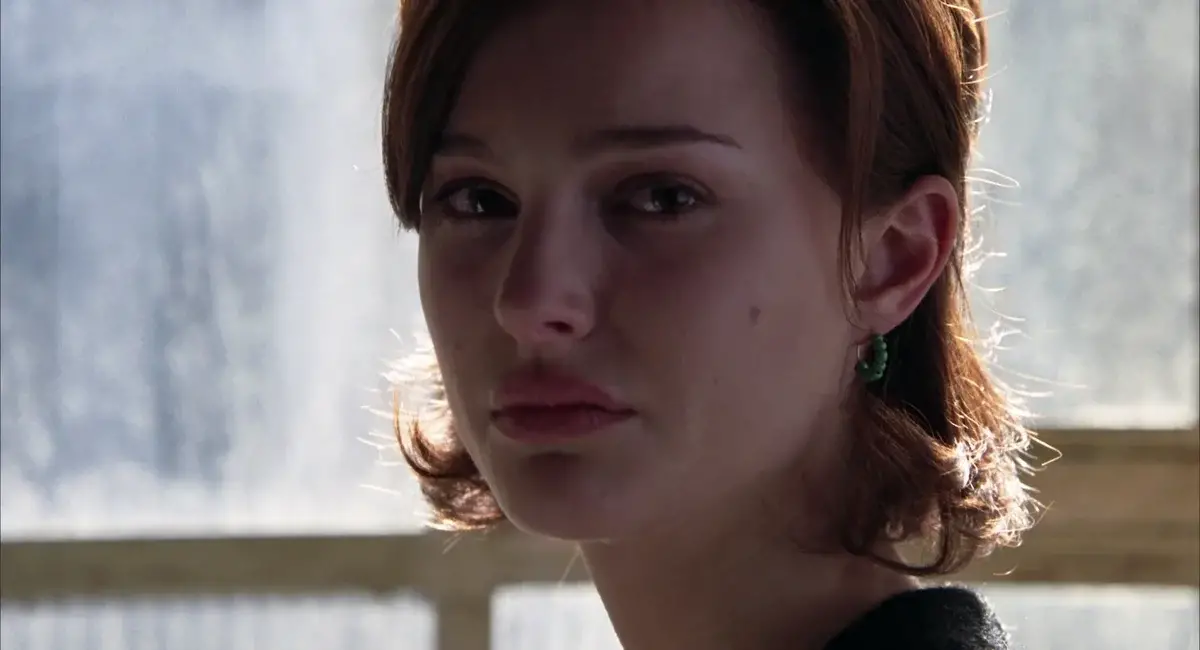Analysis of the film Closer (2004): How do the dialogues tell the story?
Based on a play by Patrick Marber
Written by Patrick Marber
Directed by Mike Nichols
Cinematographer Steven Goldblatt
Artist Tim Hatley
Music and songs by Liam Howlett, Johnny Marr and others
Cast: Natalie Portman, Jude Law, Julia Roberts, Clive Owen
Icarus Productions, John Calley Productions,
Avenue Pictures Productions
USA
2004
Screen adaptation of plays is a non-winning, ungrateful business; any play is initially static, the action takes place, as a rule, in the same place, the actors have nowhere to roam, and all this contradicts the art of the moving image (movie). Mike Nichols is one of the few who can turn the theatrical element into a screen one. The meaning of this transformation is to divert the attention of the viewer from the spectacle, external “appearance” and draw him to the characters themselves and the vicissitudes of their relationship. Theater director Mike Nichols made his film debut in 1966 with his film Who’s Afraid of Virginia Woolf? based on the play by Edward Albee received thirteen Oscar nominations, and then the creators were awarded five gilded statuettes. Almost forty years later, Nichols repeated this step, again turning to the film adaptation of the play, and two performers – Natalie Portman and Clive Owen received Golden Globes each, as well as Oscar nominations. Albee’s play was set in a university setting in New England; The action of the play by Patrick Marber, based on which this time Nichols staged the film “Intimacy”, takes place in “old” England, in bohemian London. I must say that the way “Virginia” to the screen provided the head of the studio “Warner Bros.” Jack Warner. In those years, the Hayes law was still in force – a set of rules and regulations that did not allow any liberties, in particular, verbal. In the script, the text of the play, replete with obscene language, remained almost unchanged. Warner didn’t jump on the rampage, but made a subtle detour: before submitting the film for approval to the censor, he sent it to the Catholic Film Commission, which, by a majority vote, authorized the release of it for hire (teenagers under 18 accompanied by their parents). Nevertheless, Virginia did not pass the censorship, and then Warner demanded exclusive billing for her. A permissive license was eventually granted on the grounds that the film “reflects the tragic reality of life”. As a result, Virginia Woolf buried the Hayes code.
The new situation in which the play of Marber, one of the founders of the Verbatim drama school, appeared, did not imply any difficulties with censorship. Now you won’t scare the producers with any “fucks” or surprise the public. It is also not strange that in Olbee’s play they mainly talked about sex, but in Marber’s play they deal with it, although there is no real “contact” between the characters “with us”; the elliptical composition brings the characters to the stage not at the happiest, but at the most dramatic moments when they are quite far from each other – in situations of romantic acquaintance, furious explanation or bitter farewell. What is striking is the recurrence of the dramatic conflict over such a time period, although these things are plot-wise different. Nevertheless, both there and here there are four main characters, an older couple, a younger couple, plus some additional paint in the spirit of the time, namely: two heroes are English, two heroines are American. Both here and there, the drama revolves around the earnest desire to get rid of lies (on which, in fact, well-being rests), to get to the bottom of the truth and the tragic consequences of its recognition. Both here and there, the characters perfectly feel the weaknesses of each other and subtly master the art of hitting precisely at these weak points. Moreover, we always see them in tandems, so that all their energy is directed directly to the accomplice of the “fateful duel”. and here the characters perfectly feel the weaknesses of each other and subtly master the art of hitting precisely at these weak points. Moreover, we always see them in tandems, so that all their energy is directed directly to the accomplice of the “fateful duel”. and here the characters perfectly feel the weaknesses of each other and subtly master the art of hitting precisely at these weak points. Moreover, we always see them in tandems, so that all their energy is directed directly to the accomplice of the “fateful duel”.
At one time, Nichols insisted that the role of the professor’s wife Martha be played by the star in the role of “girls who had everything” Elizabeth Taylor (she was also twenty years younger than Martha), and this caused fierce controversy in criticism. This time around, he made an equally shocking choice, casting “Queen Amidala” Natalie Portman as stripper Alice, who has so far carefully maintained her screen innocence.
Simplifying, we can say that in the first case, Nichols turned a glamorous lady inside out, revealing the insides of an ordinary woman who could swear like a fish market woman. In the second, he dissected a “decent” girl with a clear look, revealing in her a tendency to exhibitionism, not so much as a means of earning a living, but as a fun adventure for today’s “beauty of the day”. Do not believe your eyes – this is the message in the most general form that the veteran director prefaced his film.
Daniel (Jude Law) is a journalist who works for a prestigious newspaper in the obituaries department. He explains in detail to Alice the features of composing his lyrics. If you need to say the last words about an alcoholic, write: “He had special addictions.” If a homosexual is escorted on his last journey, one should write: “He was a peculiar person,” etc. The emphasis on words and deeds has changed; You can do anything, but you should speak in euphemisms. So the truth goes into inaccessible depths, perishes under a heap of lies. And it would be better not to know.
“Stranger” is the key word of the film (and the words, since the film is based on a play, are extremely important). With this word, Alice greets Daniel; The Strangers is the title of the novel Dan wrote in the wake of his relationship with Ellis. The book cover is photographed by Anna (Julia Roberts). Dan, carried away by Anna, after an unsuccessful attempt to sleep with her, sublimates his desire – he tempts Anna with the possibility of a new connection, on her behalf appointing a date via the Internet to a random interlocutor, who turns out to be Larry. As a result, Anna becomes Larry’s wife. But the spouses remain strangers to each other, strangers, and when one of them, Larry, is overwhelmed by a thirst for the truth (regarding Anna’s betrayal with Dan), the showdown ends sadly – the wife indifferently says: “I don’t love you.” Anna reacts just as indifferently to Dan’s reproach: “You broke my life!” – “You’ll survive.” You can do anything, you just need to provide an appropriate euphemism for each case. Anna asks Dan, “How did Alice feel about you stealing her life?” “Borrowed,” he corrects.
One of the most striking episodes of the film is the verbal duel between Alice and Larry in a New York strip club. Larry is ready to pay any money to be alone with the girl he likes. But it doesn’t work out completely alone – from the ceiling, his every movement is watched by a security camera. But this is not the main thing. In theory, this episode resembles one of the best scenes in the world classics – from Once Upon a Time in America by Sergio Leone, when Noodles (Robert De Niro) comes backstage to talk frankly with the woman she loves (Elizabeth McGovern), and she takes off her makeup in the course of the conversation , and painfully want her to erase it completely as soon as possible, and she erases, erases, but remains under a layer of paint, and we will never see her real face. So Alice is undressing, undressing, taking various frank intimate positions, answering questions,
The professions of all four characters are symbolic. Anna is a photographer who makes elegantly glamorous compositions from the figures of “strangers”, certifying the transience and optionality of human ties. Larry is a dermatologist, doomed to skim the surface despite his urge to get inside. Dan is a carrion embellishment specialist. Alice is a professional stripper who demonstrates her progressive closeness as she strips more and more. The meager surroundings of the film are also symbolic, primarily the aquarium where Anna and Larry’s date takes place. It refers to another early Nichols film, The Graduate, where it served as a metaphor for prison.
The British roots of “Intimacy” emerged in a clear social allusion. The most suffering (as well as the most passionate, most sincere) figure in this combination is Larry – the only character with a “blue-collar” genealogy. It is he who owns the phrase – the answer to Dan’s question, what does the human heart look like: “The heart is a fist covered in blood.” It is said a little beautifully, but beauty can be forgiven for the sake of meaning: the fist strikes – and this does not go unpunished.
The unspoken rule of cinema is: “show, not tell,” but what if you go the other way and “tell, not show.”
And the film Closer very clearly shows us how this method of storytelling works. Dialogues give us details and information that helps us move through the story and plot of the film.

frame from the movie “Closer”
In the film itself, a number of events take place that are not shown to us directly. Instead, the director and the characters in the film tell us about them directly through dialogue. And the dialogues in the film take place not only between the characters, but also between the characters and the audience.
To make it easier to understand and imagine, let’s remember the moment when Dan meets Anna. She takes pictures for Dan. From their dialogue, we learn that Dan and Alice are dating. That he wrote a book about her, and that he was interested in Anna. We were not shown exactly how Alice and Dan started dating, how their relationship developed, how they began to live together, how he wrote his book. Instead, we were told about it by the characters themselves. Adding these moments to the narratives, the film would have stretched for several hours. In addition, it would simply become boring and uninteresting for the audience. Therefore, the director uses the “tell, not show” technique. This is an unusual technique, because as mentioned above, the unspoken rule says “show, not tell.”

Another moment from the film where we (and the audience and the characters in the film) learn about Dan and Anna’s romance. We are not shown their meetings secretly from their partners, how they deceive them and go on dates with each other. Instead, we are told about it, and the characters themselves. We learn about their romance from their own words and that’s it. We are simply put before the fact.

We learn about their separation in the same way, through dialogue. The scene where the hero Dan comes to Larry at work. From their joint dialogue, we learn that they broke up and the heroine of Julia Roberts decided not to send divorce papers to a lawyer, but chose to return to her husband. We were not shown how she did it, we were told about it by two characters in a dialogue between themselves. In the same dialogue, Dan finds out about Jane’s whereabouts and goes to look for her. He finds her and the scene ends with them looking at each other. In the next scene, we see these characters lying on the bed, but we don’t know if these guys got together or not, we don’t know until they start talking. From their dialogue, we learn that they are together again.

It is important to note that the film is based on a play and I can understand this stylistic decision: to communicate all the important events through dialogue, without directly showing them. The theater stage is limited and so is the action, so it’s a very effective way to tell a story.
The film decided not to deviate much from the original source, to follow the same principle, which could make the story itself very specific, but also very interesting. At least I did not leave a strange feeling when watching the movie. The specific storytelling did not make the film worse, rather, on the contrary, it added its own special charm.

It seems to me that this is a very realistic technique, because in life we are also told about the breakup (our friends / acquaintances), and not shown. We are also For in this film we are spectators, only outside observers. And from this position, we look at everything from the outside, which means we should not see some intimate details with our own eyes and simply cannot.
The other day I rewatched a nice movie with Julia Roberts, Jude Law and Natalie Portman in the lead roles. A film called “Closer”. It may be familiar to many from the soundtrack “I can’t take my eyes of you”, a very romantic and beautiful song by Damien Rice :-)) -the rhythm of life, when there is not always enough time for news release :-)) But still I returned to this picture, and I must say, not with a simple one. And all because when I listened to lectures on system-vector psychology, this film came to my mind more than once. Why? I’ll try to share my thoughts 🙂
The plot, in a nutshell, is this. A young and eccentric American woman (Natalie Portman) arrives in London, walks down the street – all so out of the London gray-suited public … A very intelligent, incredibly refined young man (Jude Law) is moving towards her, and then … A girl hit by a car. Wait to get upset 🙂 Not to death. She wakes up in the hospital and the first thing she sees is the face of a handsome stranger (Jude Law). What happens next is not difficult to guess 🙂 The girl is very pretty, a little wonderful and she has nowhere to live)) The young man is all so polite, tired of a refined society, begins to sympathize with her, even though she seems a little crazy to him, one job in a striptease and the appearance is worth it)) But … as you know, opposites in this sense sometimes attract))
The hero of Jude Law is a young writer who plans to release his book. Goes to a photo session with a famous and accomplished woman photographer (Julia Roberts). She is incredibly sexy – strict and tall, smooth and strong-willed at the same time. She is at that age and development when not a single young girl can compare with her, no matter how cute her face and fresh skin is)) Jude Law’s hero instantly loses his head, understands: Here she is – a woman!)) Between them there is a mutual passionate attraction, but she ends the relationship after a single passionate kiss, realizing that he is too young to be her match.
Naturally, the guy is furious because he cannot get what he so passionately wants. He decides to play a joke on her. Enters the chat for easy sexual acquaintances under her name, and chats with a guy – makes a date. (The content of the correspondence does not allow me to quote :-)) Arranges so that Anna (Julia Roberts) comes to the right place. There she meets a guy “from the chat.” They both realize that they have become the victim of someone’s merciless joke. But this only brings them closer, and they start dating. Chat Boy is a successful London dermatologist, the exact opposite of Jude Law’s hero – emphatically masculine, somewhat aggressive, assertive and uncompromising. What attracted Anna to him? – hard to say. But they began to officially meet, and got married.
With all this, the young rake-writer in the person of Jude Law did not calm down)) He came to the opening of Anna’s exhibition with his girlfriend (Natalie Portman), who, in turn, liked Anna’s chosen one with her young charm. Further, as in the well-known song about the school ensemble)) Not just a triangle is formed, a real love square is formed)) And all the consequences of this … But I already want to look at this “square” from the point of view of system-vector psychology. A spectacle that really deserves the attention of a system psychologist))
The heroine Natalie Portman, a young skin-visual woman, is still far from being at the peak of her development. Works as a stripper, very provocative, men are literally ready to shake out their wallets, seeing her curving young body. Of course, she does not leave indifferent the anal doctor, the husband of the heroine Roberts.
The hero of Jude Law, a young writer, is cold in English and a little infantile. Being the bearer of both anal and visual vectors, he falls deeply in love, first, with the less developed skin-visual heroine Portman, feeling the desire to take care of her, and later he simply loses his head when he sees the wise and developed heroine Roberts. The heroine Roberts is in a state of love, does not demand anything for herself, but only bestows him with tenderness, akin to a mother’s. Her taste is sweeter for him than what his young girlfriend in the face of Portman can give him. Enraged by the betrayal, anal husband Roberts screams at the back of the destroyed Lowe: She said that you woke up at night in tears, calling your mommy, and poking into her chest.
The story is not flattering, but it ends quite optimistically. The heroine Natalie Portman leaves her English boyfriend and returns to America – matured, smoothly combed and less inconsistent in her behavior)
) femininity of the heroine Julia Roberts.
And the characters of the film, as if our old acquaintances are telling us about their lives. They tell but don’t show it.







